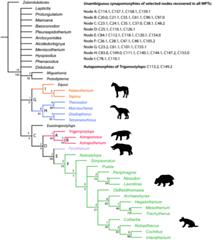Project 4079: R. MacPhee, S. H. Del Pino, A. Kramarz, A. M. Forasiepi, M. Bond, R. B. Sulser. 2021. Cranial Morphology and Phylogenetic Relationships of Trigonostylops wortmani, an Eocene South American Native Ungulate. Bulletin of the American Museum of Natural History. 449 (1):1-183.

Specimen: † Trigonostylops wortmani (AMNH VP-28700/AMNH VP-28700:AMNH VP-28700)
View: na
View: na
Abstract
In 1933 George G. Simpson described a remarkably complete skull of Trigonostylops, an Eo-Oligocene South American native ungulate (SANU) whose relationships were, in his mind, quite uncertain. Although some authorities, such as Florentino Ameghino and William B. Scott, thought that a case could be made for regarding Trigonostylops as an astrapothere, Simpson took a different position, emphasizing what would now be regarded as autapomorphies. He pointed out a number of features of the skull of Trigonostylops that he thought were not represented in other major clades of SANUs, and regarded these as evidence of its phyletic uniqueness. Arguing that the lineage which Trigonostylops represented must have departed at an early point from lineages that gave rise to other SANU orders, Simpson reserved the possibility that Astrapotheriidae might still qualify (in modern terms) as its sister group. Even so, he argued that the next logical step was to place Trigonostylops and its few known allies in a separate order, Trigonostylopoidea, cognate with Astrapotheria, Notoungulata, Litopterna, and Pyrotheria. Simpson’s classification was not favored by most later authors, and in recent decades trigonostylopids have been almost universally assigned to Astrapotheria. However, his evaluation of the allegedly unique characters of Trigonostylops and its allies has never been systematically treated, which is the objective of this paper. Using computed tomography, the skull of Trigonostylops is compared, structure by structure, to a variety of representative SANUs as well as extant perissodactylans (which together comprise the clade Panperissodactyla) and the “condylarthran” Meniscotherium. In addition to placing Simpson’s character evaluations in a comparative context, we also provide detailed assessments of many vascular and pneumatization-related features of panperissodactylans never previously explored. Overall, we found that this new assessment strengthened the placement of Trigonostylops within a monophyletic group that includes Astrapotherium and Astraponotus, to the exclusion of other SANU clades. Although Trigonostylops cannot be considered as morphologically distinct or unusual as Simpson thought, our comparative and phylogenetic analyses have helped to generate a number of hypotheses about character evolution and function in SANUs that may now be fruitfully tested using other taxon combinations.Read the article »
Article DOI: 10.1206/0003-0090.449.1.1
Project DOI: 10.7934/P4079, http://dx.doi.org/10.7934/P4079
| This project contains |
|---|
Download Project SDD File |
Currently Viewing:
MorphoBank Project 4079
MorphoBank Project 4079
- Creation Date:
06 September 2021 - Publication Date:
09 September 2021 - Media downloads: 1

Authors' Institutions ![]()
- Consejo Nacional de Investigaciones Científicas y Técnicas (CONICET)
- Museo Argentino de Ciencias Naturales Bernardino Rivadavia
- American Museum of Natural History (AMNH)
- Museo de La Plata
Members
| member name | taxa |
specimens |
media |
| Ross MacPhee Project Administrator | 1 | 2 | 1 |
Project has no matrices defined.
Project downloads 
| type | number of downloads | Individual items downloaded (where applicable) |
| Total downloads from project | 56 | |
| Project downloads | 49 | |
| Document downloads | 6 | Trigo matrix (5 downloads); Character labels and state descriptions (1 download); |
| Media downloads | 1 | M823590 (1 download); |
